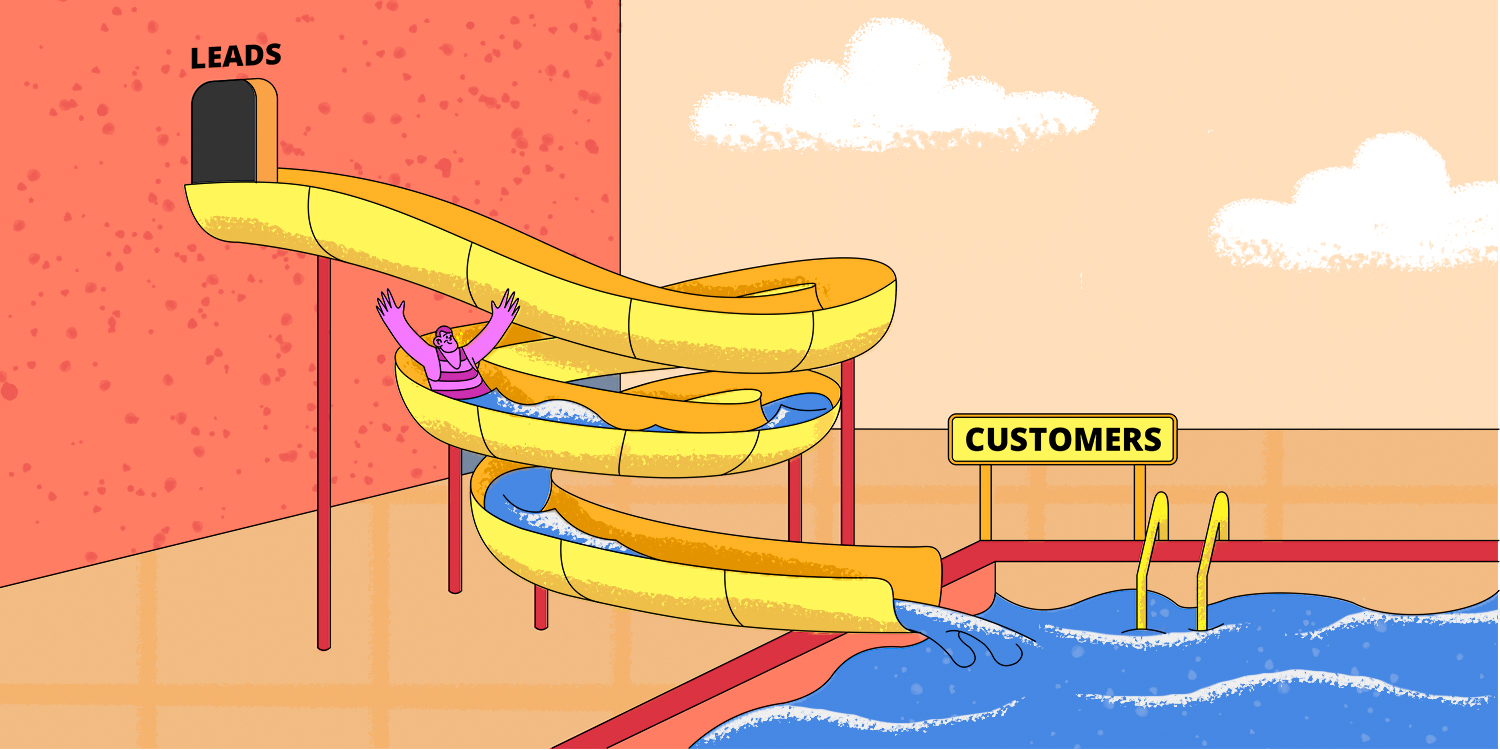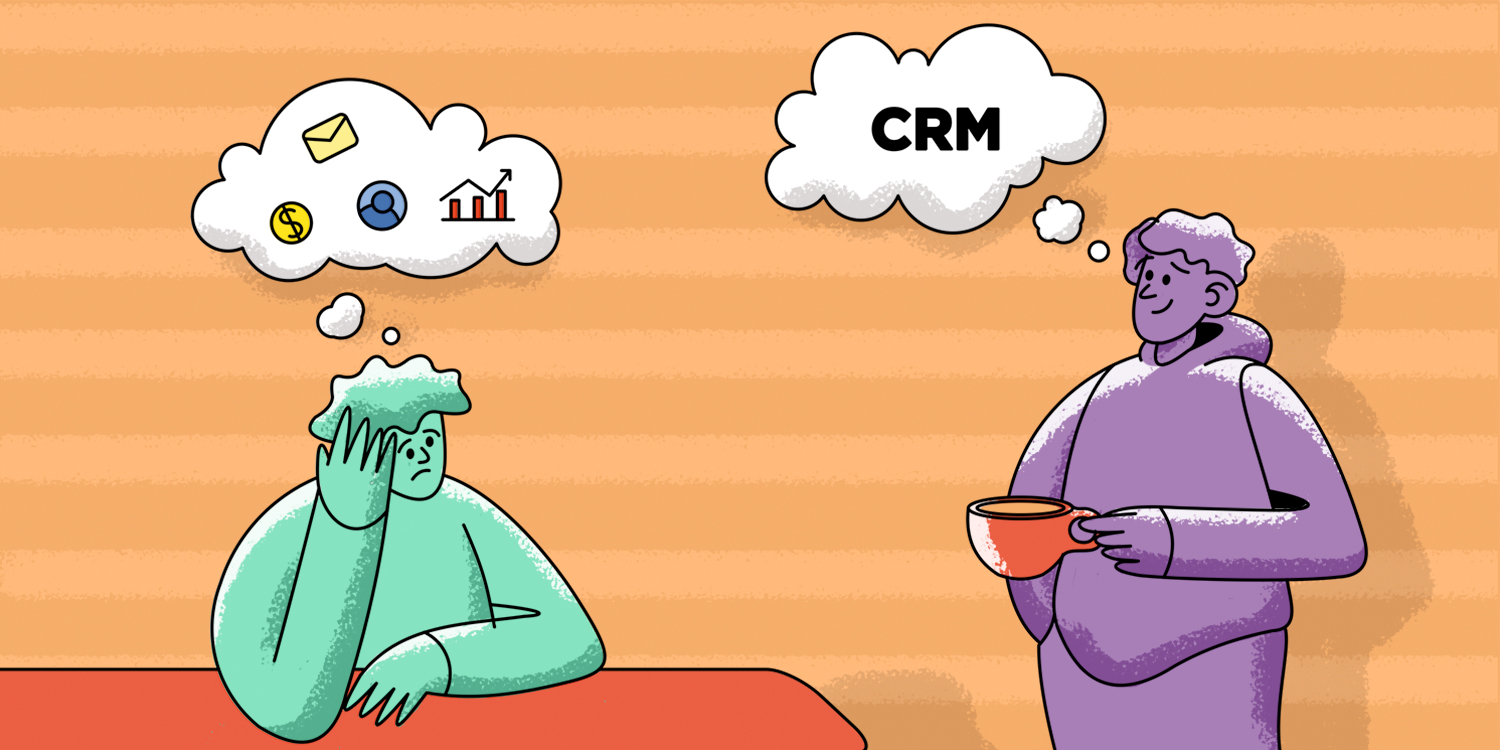When you’re just starting up, you don’t have a strong sales team to take responsibility for sales progress. The only thing you have is a desire to win your first clients.
It’s challenging… But not when you understand how the sales process works step by step.
We’ve compiled this short guide and covered the most crucial steps, such as sales cycle stages and finding quality leads, to help you make a confident start in B2B sales.
Outline:
What are B2B sales?
B2B sales, or business-to-business sales, refer to a sales process between companies. Just as understanding B2B sales is crucial for success, comprehending various saas revenue models can significantly impact a company’s financial strategy and growth trajectory. For example, a SaaS company selling its product — email marketing software — to another company is involved in B2B sales.
B2B sales vs. B2C sales: what’s the difference?
B2B sales are often viewed in contrast to another type of business relationship — B2C, which stands for business-to-consumer. B2C sales are all about selling products directly to an individual customer who is also the final consumer (an online store where you’re buying clothes is an example of a B2C business).
There are several significant differences between B2B and B2C sales:
B2B sales have a higher average transaction value. Whereas in B2C, sellers may sell one product to one end-user, businesses often buy in bulk and have much higher price tags.
B2B sales involve more decision-makers. While in B2C, a seller needs to convince only one person to buy their product, in B2B, salespeople have to deal with several stakeholders before they complete a sale.
B2B sales cycle is longer. Unlike in B2C sales, in the B2B world, there are no impulse-based purchases. Buyers take more time to make final decisions. According to the research from CSO Insights, 74.6% of B2B sales to new customers take at least four months to close, with 46.4% taking seven months or more.
In B2B sales, pricing is more flexible. While in B2C, a consumer generally accepts a stated price, in B2B sales, the price can sometimes be negotiated.
In B2B sales, the payment is more complex. When it comes to B2C sales, the transaction is typically settled on the spot. Meanwhile, B2B payment processing requires more time to approve, so the transaction may take days or weeks.
In B2B sales, customers are more educated. They are more selective about the business they want to deal with and usually have their own buying criteria, unlike B2C buyers, who often need help from a salesperson.

Understanding the sales cycle
A sales process isn’t something that occurs only once. Once you close a deal, you move back to the very first stage, generating, nurturing, and converting yet another prospect. It’s a never-ending cycle. In fact, while talking about a sales process, salespeople do indeed use the term ‘sales cycle.’
But what is a sales cycle?
A sales cycle is a cyclical sequence of activities sales reps go through to convert a new customer. As a rule, it consists of seven stages:
1. Prospecting — At this stage, you are searching for new leads either by doing online research on such sites as LinkedIn or building contacts at conferences and industry events.
2. Connection — Here, you are reaching out to your new leads to gather more information about them via a cold email, a message on social media networks, or a discovery call.
|
Send emails and personalized messages on LinkedIn in one comprehensive email drip campaign with Snov.io’s LinkedIn prospecting tool! |
3. Lead qualification — Now that you’ve collected data about your prospects, you decide whether they’re a good fit for your business and hence should be moved further into the sales funnel.
4. Pitch — At this stage, you demonstrate your product or service to your prospect.
5. Objection handling — As it’s common for prospects to have objections, you might need to overcome them whenever any arise.
6. Closing a deal — This stage encompasses all activities taking place when the sale approaches closing, e.g., negotiation, delivering a quote or proposal, achieving the buy-in of decision-makers, etc. As soon as you’ve closed the sale, your prospect becomes your customer.
7. Nurturing new customers — You should continue communicating with your new customers and reinforcing the value of your solution to make them repeat their purchases or bring you new leads through referrals.

To better understand a sales cycle, you should grasp how prospects proceed to purchase from the perspective of both a buyer and a salesperson.
So, before we dive into the anatomy of the business-to-business sales process, let’s consider three basic notions that relate to your sales cycle: a buyer’s journey, a sales funnel, and a sales pipeline. These terms are often mixed, so you should draw a line between them to avoid confusion.
Buyer’s journey vs. Sales funnel vs. Sales pipeline
Buyer’s journey
A buyer’s journey describes the prospect’s path to the purchase. It commonly includes three steps:
- Awareness — At this point, the prospect realizes there is a problem they need to resolve, though they haven’t determined what’s causing it. For you, it’s not time to sell yet. Instead, you should offer them content that would educate them on their pain points.
- Consideration — Here, the prospect defines their problem and considers options to solve it. Now you should take steps to help them understand how they can benefit from your solution.
- Decision — At this step, the prospect evaluates and decides on the right solution strategy and chooses products and services that will help them fix the problem. It’s finally time for you to sell your company as an ideal solution provider!

As you see, a buyer’s journey approaches the sales process from a customer’s perspective. But what about a salesperson? That’s where a sales funnel comes into play.
Sales funnel
A sales funnel, also known as a purchase funnel, is a series of steps your prospective customer goes through before they reach the point of buying your product or service. The word ‘funnel’ here ideally depicts how the sales process goes: from many leads who join your list, only a few turn into paying customers.
The modern sales funnel consists of five stages:
- Awareness — At this stage, you make people aware of your product (e.g., with the help of content marketing, social media campaigns, SEO, etc.).
- Interest — Once a lead has converted from the awareness phase, you capture their interest, making them realize your solution can satisfy their needs.
- Consideration — At this point, you focus on how to demonstrate your competitive advantages as your prospect will be studying your solution carefully and evaluating it against your competitors.
- Decision — Now your prospect is ready to buy your product. Negotiate all important details of the deal and develop irresistible incentives (e.g., offering a free trial, a discount, informing them about your loyalty program, etc.).
- Purchase — Congrats, you’ve done it! Your prospect has become your customer! What you need to do now is to keep on engaging with them and providing personalized attention so that they make another purchase from you.
Sales pipeline
A sales pipeline is a number of stages sales opportunities move through before being closed. Basically, it refers to every step in your sales process that a sales representative takes to convert a lead into a customer.
Its stages vary from company to company, but a typical sales pipeline includes five steps:
- Lead generation (prospecting) — At this stage, you collect a list of potential customers.
- Lead qualification — After you’ve generated leads, you determine which of them are more likely to buy your product.
- Contact — Here, you start contacting potential customers (either through a call, an email, conducting a meeting, etc.).
- Proposal — At this stage, you send your prospect a detailed quote outlining the cost and the terms.
- Closing a deal — That’s the stage where you sign the deal, and your prospect becomes your customer.

Now, one more time:
A buyer’s journey describes the process of making a purchase from the perspective of a buyer.
A sales funnel also looks at how the buyer is moving to the purchase, but from the perspective of a seller.
A sales pipeline looks at what steps sales guys must take to move leads from the top of the funnel through to the sale.
How to start selling: B2B sales process step by step
Phew, that was a lot of information, wasn’t it?
Buckle up; now we’ll dive deeper into the business-to-business sales process, splitting it down into simple steps for your smooth start.
Step 1. Determine your value proposition
Your very first task when building your sales process is to determine your value proposition, i.e., why people should buy your product. Make a clear statement about your brand to highlight your benefits in an easy-to-grasp and measurable way.
For example, for SaaS products, there exist three types of value propositions:
- Software that increases revenue,
- Software that reduces cost, and
- Software that promises improved productivity.
While formulating your value proposition, be as accurate as possible. Generic statements like “Our service will help you increase revenue” won’t be enough as your prospects will want to know by how much.
Here’s an example of a value proposition that would be more effective in this case: “Our service helps companies like yours to increase their revenue by 20% within the first year.”
Step 2. Define your ideal customer profile
Now you need to determine what companies will be your ideal customers, those who would benefit from your solution and provide you with significant value in return. Without identifying your ideal customer profile (ICP), you’ll be wasting your resources targeting people that will never buy from you.
First, think of a broad group of companies within a particular industry (e.g., real estate). Then narrow down your scope to specific parameters (location, company size). Finally, think of a person you’ll be reaching out to within a company.
You should try to reach decision-makers, as these stakeholders have the power of passing company resolutions and deciding whether their organization will buy your product or service.
Step 3. Create a sales plan
You can’t go far in sales if you don’t have a strategic plan in front of your eyes. You need to prepare the sales plan that would include:
- Your business and revenue goals,
- ICP,
- Customer segmentation and tactics you’ll use for each segment,
- Market conditions,
- The budget you’ll allocate,
- Sales strategies, and
- Performance criteria to track the success of achieving your sales targets, etc.
An essential aspect of your sales plan is having definite deadlines. Ensure you’ve broken down your big sales goals into smaller milestones and set deadlines for achieving each of them. This will help you take complete control of the process.
Step 4. Generate your leads
Now it’s high time to find potential customers. There are two ways you can generate leads: inbound or outbound.
Inbound lead generation
Inbound lead generation means that your prospective customers find you on their own, so they themselves decide to interact with you. You can use the following inbound lead generation strategies:
- Content marketing (A good piece of advice is to start your blog where you’ll write high-quality articles and guides, offer lead magnets, create valuable videos and podcasts, etc.).
- Social media (You can use social media platforms for blogging and spread the word about your business all at once).
- SEO (Once you have lead generation content to share, think about making it rank high in search engines by adding keywords and phrases that correspond to search queries)..
Outbound lead generation
Outbound lead generation presupposes that it is you who finds the leads that are more likely to turn into your customers. Contrary to inbound lead generation, outbound leads are harder to convert as they are not initially interested in your offer.
Nevertheless, outbound lead generation matters a lot for startup companies. Their product is not yet top-performing, so they can build brand awareness and collect leads faster with its help.
Among the best outbound lead generation strategies are the following:
- Pay-per-click (PPC) advertising (If your startup has a budget to spend and perfectly knows their target audience, you can run paid ads on Facebook, Google Search, ad networks, etc.)
- Cold outreach (Your first-aid when you want to generate leads on a budget! This strategy presupposes collecting leads and reaching out to them via cold email, cold calling, connecting on LinkedIn, and so on).
And, of course, you shouldn’t disregard the word-of-mouth means of generating leads, asking your customers for referrals.
Step 5. Qualify your leads
As soon as you’ve generated leads, you should ensure they are qualified, i.e., are likely to become your customers, hence worthy of your time and efforts.
Overall, you can qualify leads in two ways:
1. By doing research before you reach out
Study the company profile of your prospect, their annual budget, number of employees, and just any information available.
You can use special tools that enable you to find already qualified leads, such as Snov.io’s Database Search. With its help, you can find B2B leads that fit your ICP based on specific parameters (industry, location, company size, name, and founding date).
2. By asking your leads directly
You can find out more about your leads via sending them an email or conducting a discovery call. Ask them sales qualifying questions and filter out the list of your leads, leaving those that have money to afford your solution, really need it at the moment, occupy decision-making positions, or can connect you with the decision-makers.
Step 6. Make a sales pitch
Only when you have qualified your leads can you initiate your sales pitch. Ideally, it would help if you did it via a sales meeting (either in-person or video call).
Focus on the customer’s needs and pain points rather than talking about your product and its useful features. That’s the right time for asking critical questions, in particular, the questions that would help your prospects voice their problems, understand how they can benefit from your solution, realize your competitive advantage, and just get charmed by the way you can handle their sales objections.
Step 7. Close the sale
Be prepared that you’ll have dubious feelings at this stage. On the one hand, you are close to winning the deal, lifting your spirits as high as never before. On the other hand, this is a serious step that demands patience and refined communication skills. You should prepare your contract in advance and be ready for negotiations, which in some cases may last weeks or even months.
Once you’ve got a new customer, be quick to organize an effective onboarding process for them to understand the value of your product from the very first day. And never stop providing your new customers with your brilliant support!
Step 8. Nurture your customers
I wish I could stop at the ‘Close the sale’ step, but I can’t omit this critical stage of your sales process. Without it, you won’t ensure long-term sales success and constant business growth.
As soon as you convert your prospects into paying customers, you should put effort into making them stay and repeat their purchases. Why?
Customer retention will cost you less than new customer acquisition. Besides, your existing customers are easier to sell to, 50% more likely to try new products from your brand, and will spend 31% more money with you than new customers.
So, never stop engaging with your customers after they’ve made a purchase. Instead:
- Send them valuable guides,
- Reward most loyal customers with exclusive offers,
- Celebrate holidays and anniversaries,
- Notify them whenever the price drops,
- Send them annual summaries of their relationship with your brand, etc.
And remember, this final step of the sales process can make the beginning of your next cycle.
Tips on running successful B2B sales campaigns for startups
Now that you’ve got a step-by-step plan on how to start selling, consider some tips that will help you boost your sales with a rocket speed.
Elaborate on your sales outreach and follow-up strategy
Sales are always about communication, so reaching out to prospective and existing customers is your engine of growth.
Once you’ve collected leads, segment them to make your outreach as personalized as possible.
And don’t forget that in sales you should be persistent. Never stop at one message; follow up relentlessly! I would really recommend that you print this statistic and pin it above your laptop:
Don’t give up. 50% of all sales happen after the 5th contact.
And if you decide to follow up via email, we’ve prepared free follow-up email templates to help you engage effectively with your prospects.
Analyze your performance
Another essential factor of growth is analytics. And this is not only about tracking the numbers. Get used to analyzing your performance at every stage of a sales cycle, taking lessons from lost deals, all with a single aim — to solve these issues for your next sales prospects.
Besides, you should regularly ask for customer feedback to monitor their satisfaction and improve their overall customer experience. Be open to complaints and remarks!
Use sales automation
No matter at what level your business is now, sooner or later, you’ll understand that your sales process can’t rest solely on your manual work. Your customer base will grow, so will interactions with your prospects, and just the amount of headache connected with your everyday tasks.
Take it seriously and think about a reliable tool to scale your sales process. The best solution will be finding a CRM that will effectively cope with your sales tasks. Snov.io is just one of them, offering you multiple features for sales prospecting, sales outreach, performance tracking, and much more.
→ If you’re looking for limited-time software savings, check out our updated guide to the best Black Friday SaaS deals available this year.
Wrapping up
When you only start your way to success, you may look really lost. It’s okay. Rome wasn’t built in a day. Just don’t give up!
We’ve prepared this simple guide to help you make your first steps in business to business sales. But if at any step you feel confused, remember, Snov.io has a lot more helpful guides, supportive templates, and most importantly, a professional CRM platform for your sales growth.






